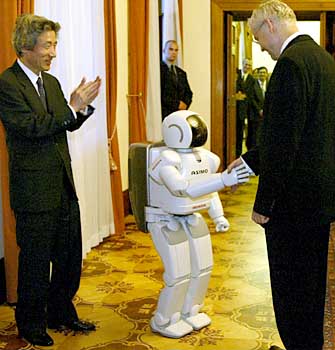What happens when the laws we create can't protect us?
The word Robot is a widely used English word first introduced in 1923 when Czech writer Karel Capek wrote the play Rossum’s Universal Robots (R.U.R.)—published in 1921. The term “Robot” itself comes from the Czech word, Robata, meaning “servitude, or forced labor, and was first used by Karel's brother, Josef (Robot-definition, Wikipedia).
As the individual who first published the term “robot,” Capek also seemingly pinpointed one of the most prevalent themes regarding robots in both literature and cinema. Just as in R.U.R.’s plot, the prevailing theme regarding robots is classic: Man creates robot, robot kills man.

courtesy of
common.weblogsinc.com
Despite being credited as the first to use the word “robot,” many feel that it was Mary Shelley’s Frankenstein, that introduced the first of the artificial life forms to fit the model of the creator losing control of the created.
20 years after Capek introduced the “robot,” Isaac Asimov used the word “robotics” to describe the technology of robots; and he predicted the rise of a powerful robot industry. A year later, in 1942, Asimov wrote "Runaround", a story about robots which contained the famous "Three Laws of Robotics":
1.
A robot may not harm a human being, or, through inaction, allow a human being to come to harm.
2.
A robot must obey the orders given to it by human beings, except where such orders would conflict with the First Law.
3.
A robot must protect its own existence, as long as such protection does not conflict with the First or Second Law
(Isaac Asimov's Robot Series-Wikipedia).

courtesy of www.spiegel.de/img/
Robotic Dystopias can be most easily defined as societies in mechanical chaos. These are places in time and/or space where the creators (humans) have lost control of the created (robots): this loss of control occurs over a spectrum, from the rebellious yet harmless robot, to Capek’s man creates robot, robot kills man. The robots that are responsible for these dystopias are expressed in different ways: some are survivalists, some imperialistic in nature. Some robots are confused, while others have a cold-heartless hatred for humankind; determined to destroy or subjugate all humans.
Very often, readers/viewers will see that many Science Fiction (SF) stories dealing with robots/robotics are rooted in Asimov’s Three Laws of Robotics. The dystopias that arise in these tales are caused by robots that somehow overcome, defy, or slip through the “perfect circle of protection” found in the Three Laws.
![]()